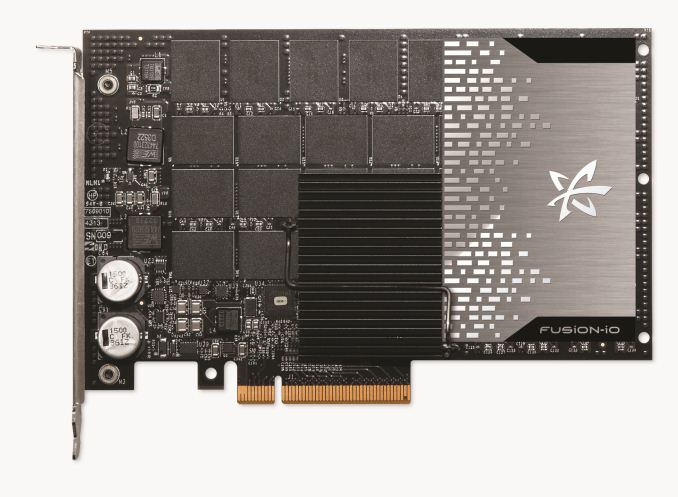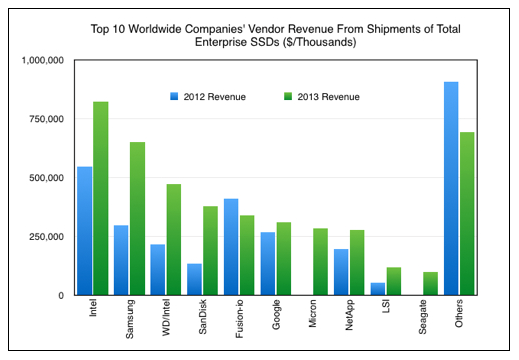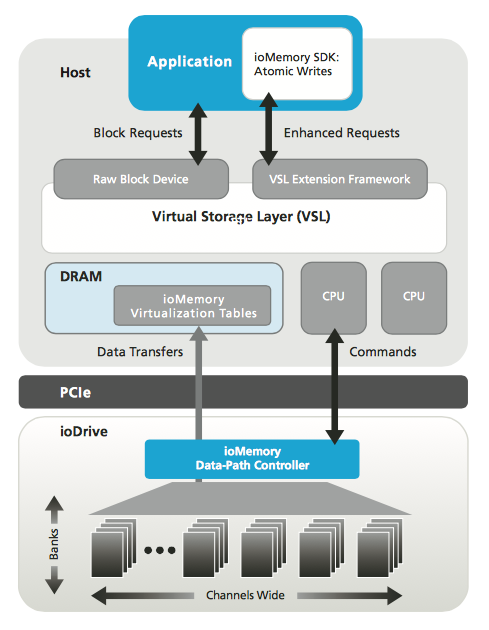The State of SanDisk
by Kristian Vättö on December 5, 2014 8:00 AM ESTThe Enterprise
In mid-July SanDisk announced their acquisition of Fusion-io and the acquisition was completed a couple of week prior to Flash Memory Summit. I posted my initial thoughts when the news hit the public, but I feel that it's worth doing a bit deeper analysis now that I have given it some more thought and discussed it with John Scaramuzzo, senior vice president and general manager of SanDisk's enterprise business.
SanDisk has managed to establish itself as one of the key players in the enterprise SSD space over the past few years. The acquisitions of Pliant in 2011 and SMART Storage Systems in 2013 provided SanDisk with strong expertise and product lineups for SATA and SAS SSDs but left the company without a solid long-term plan for PCIe. I heard Pliant's initial roadmap included plans for PCIe-based solutions as well, but it looks like those plans never materialized.
Up until the Fusion-io acquisition, the Lightning PCIe SSA was the only PCIe solution in SanDisk's enterprise product portfolio, and as a matter of fact that drive is internally a SAS-based design with a PCIe to SAS bridge onboard. In other words, SanDisk had practically zero real PCIe solutions for the enterprise, while at the same time SanDisk's biggest competitors, such as Intel and Samsung, have had PCIe drives for a long while already.
Fusion-io's 3.2TB Atomic Series SSD
Fusion-io's strategy and product portfolio, on the other hand, was a complete opposite. From the beginning Fusion-io has focused on PCIe storage, which dates all the way back to 2007 when the company released its first ioDrive that utilized a PCIe x4 interface and was capable of speeds up to 800MB/s. Not only was Fusion-io early in the market, but the company was also able to garner a few massive and very important clients – the most notable being Facebook and Apple. I don't think it's an overstatement to say that Fusion-io can be considered as the pioneer of PCIe storage because it was the first company to turn PCIe SSDs and storage in general into a large, successful business.
But stories eventually come to an end. The competitive advantages Fusion-io had were its PCIe technology and several high-level customers, but the advantages were lost when the NAND manufacturers stepped into the PCIe territory. It's nearly impossible for a company that has to source its NAND from a third party to compete against another company that manufactures NAND in-house since the latter will always have advantages in cost. While Fusion-io didn't lose its customers to competitors overnight, it's clear that especially Intel and Samsung snagged a share of Fusion-io's business in the past couple of years.
In a nutshell, the acquisition brings SanDisk the long-needed expertise in PCIe storage along with Fusion-io's broad PCIe product portfolio. The acquisition is now a bit over 100 days in and the Fusion-io employees have been integrated into SanDisk's existing teams. Initially Fusion-io's engineering team was separate and worked under Lance Smith, the former President and COO of Fusion-io, but Mr. Smith decided to leave SanDisk and pursue other options. Last week a data virtualization startup Primary Data announced that Mr. Smith has joined the company as the new CEO, which explains his quick departure from SanDisk.
All the engineering talent has now been unified and the team is lead by Mr. Scaramuzzo. With everyone under the same roof, the roadmaps are now in the process of being integrated to bring the expertise together. It will be a while before we see the fruits of the acquisition, but in the meantime the latest Fusion-io products will transition to SanDisk NAND for increased cost efficiency.
But what about NVMe? That has been the hot topic in the industry this year and I bet many of you are wondering what is SanDisk's and Fusion-io's play in that field. The short version of their strategy is that Fusion-io already has a technology called Virtual Storage Layers (VSL), which is essentially a driver/software stack similar to NVMe. The truth is that NVMe isn't really anything new from a technology perspective, but what makes it alluring for many manufacturers is the fact that the NVMe drivers are universal and already supported by the latest operating systems. Technologies like VSL are rather expensive to develop and require expertise because there is no framework available (i.e. everything has to be developed from scratch), but on the other hand an in-house driver like VSL allows for more customization and optimization.
However, that doesn't mean that SanDisk has no interest on NVMe whatsoever. The company sees that as the entry and mid-level enterprise SSDs move from SATA and SAS to PCIe, NVMe will be one of the key factors because of easy and quick deployment. For that market segment the NVMe spec and its limitations are fine – it's only the high-end segment where the benefits of VSL are more prominent. It's actually likely that many manufacturers will turn to custom NVMe drivers anyway for higher and more optimized performance, and in fact that is already happening with Intel providing its own NVMe driver for the P3600/P3700.
Lastly, let's quickly discuss the ULLtraDIMM. I wrote a quick piece on ULLtraDIMM right after Flash Memory Summit, but SanDisk has already scored Huawei as the third ULLtraDIMM partner (in addition to IBM and Supermicro). The first generation product that is currently available is internally based on a pair of SATA 6Gbps controllers, but SanDisk said that a native DDR to NAND controller is possible in the future if the market adopts the new form factor well. As usual, the industry is fairly slow in adopting new form factors, so it's hard to say whether NAND DIMMs will really take off, but it's a very interesting and potentially useful technology.
Final Words
All in all, SanDisk is definitely one of the most interesting NAND companies going forward. USB drives, eMMC solutions, SSDs and even the storage arrays from the Fusion-io acquisition are all built on NAND, which puts SanDisk in a unique position as it's the only NAND manufacturer that focuses solely on NAND products. The company can't turn to alternative revenue sources like e.g. Intel and Samsung can, but on the other hand that's also SanDisk's strength as all the know-how and experience in the company is related to NAND in one way or the other.
Ultimately next year will be crucial for SanDisk because it determines whether the company can materialize all the underlying potential from the Fusion-io acquisition and become a serious competitor to Intel and Samsung in the enterprise space. The pieces are definitely there, so it's just a matter of execution now.














132 Comments
View All Comments
hojnikb - Friday, December 5, 2014 - link
>This is actually the part where we ask for your, our readers, help. What is it that we or manufacturers like SanDisk could do to boost the SSD penetration in the market? Would live demonstrations at malls and other public places help? Or upgrade programs where you could take your PC to a store and they would do the upgrade there for you? Let us know your ideas in the comment section below and I'll make sure to bring them up with SanDisk and other SSD manufacturers. Remember that we are talking about the masses here, so think about your parents for instance – what would it take for them or other people who are not very comfortable around computers to upgrade their PCs with an SSD?Try before buy or something similar. Let the user try the ssd for themselfs and they are not satisfied with the performance and responsivness, then they can bring it back. Obviously live demonstrations and help with install would greatly help aswell.
As far as OEMs are concerned; they should start offering base models with ssds instead of HDDs. I bet that a cost efficiently designed msata/m.2 ssd of 64/128GB size could potentialyl be cheaper than 500/1TB harddrive.
FITCamaro - Friday, December 5, 2014 - link
A demonstration would have to show real world results showing the difference. Merely booting up faster isn't that big a selling point to most. An extra 30 seconds of faster boot (something you do once a day) isn't worth the drastic cost per GB difference for most. Even as an enthusiast for me it still isn't. Granted now I have all the HDD storage I'm going to need for a long time (two 3TB drives), I'm just waiting for the extra cash to pick up a 240-256GB SSD for games to replace my 120GB one since space is becoming an issue. But my OS is still on a traditional 1TB drive. That will eventually change but it's not a priority.At the end of the day, SSDs are still largely too expensive for most. They see the small size and are like "what the heck?". More are adopting cloud storage as a viable option, but that's the real sell. Convincing people they can make do with only a 64-120GB drive onboard while using cloud storage for everything else. People are spoiled with being able to keep their entire music collection on their laptop.
hojnikb - Friday, December 5, 2014 - link
Considering that consumer space is moving towards cloud and streaming, having less much much faster storage makes a lot of sense. Who really needs a 1TB drive and actally _uses_ it ?Probobly not a lot of people. And by giving base models ssds instead of hdds this could potentially mean lower prices if done right. And consumers love lower prices.
paddytokey - Friday, December 5, 2014 - link
Completely agree with that, additionally a lot of people have bought external Harddrives over the last couple of years to store all their stuff on. I think having a 128GB+ SSD in a low-priced pre-built computer makes a ton more sense nowadays as it will benefit you in everyday tasks and makes the machine feel so much snappier.nathanddrews - Friday, December 5, 2014 - link
Three benchmarks in store or on YouTube that would likely impress Average Joes:1. Opening and editing pictures/slideshows/movies on something like PS Elements
2. Playing and MMO like WoW or Marvel Heroes, something that is disk intensive that actually affects gameplay
3. Opening, editing, and saving large MS Office projects
StevoLincolnite - Friday, December 5, 2014 - link
Unfortunately, games are starting to balloon in install size.50Gb+ is the norm going forward.
SSD's simply aren't cost effective for a "games" drive.
My Steam Library for instance, with over 500 games consumes almost 3 Terabytes (And that's JUST Steam!), yes I like to have everything installed and ready to-go, always, with a backup on another drive.
I simply do not wish to waste time, downloading/transferring/copying/moving games all the time to an SSD, just click and play.
So, I just use a mechanical for everything else and a several-year-old 64Gb OCZ Vertex 2 SSD for my Windows install.
I did just picked up a Sandisk Readycache drive though, hopefully I can configure it to cache my games drive, otherwise it's going into my grandmothers PC.
Stochastic - Saturday, December 6, 2014 - link
I don't have the time or interest to play 500 games. At any given moment I'm usually actively playing no more than one or two games. If Gigabit internet ever becomes ubiquitous this will become a non-issue as downloading games will only take a handful of minutes.amddude10 - Sunday, December 7, 2014 - link
You can also backup and restore backups with steam very easily to and from hard drives, whenever you decide to switch what games you're playing. One of the nice things about SSD's is that they can easily handle reading or writing to or from a hard drive as fast as that hard drive can go, whilst also still being able to load or save other programs or files onto it while you wait for your backup or backup restoration to finish. It's way faster than a gigabit internet connection.fokka - Sunday, December 7, 2014 - link
i think booting windows and autostarting programs like browser, itunes etc would get the biggest wows from novices. many people are used to waiting 1-2 minutes and more until they can even use their hdd-equipped computer, with a nice ssd-equipped system that should take less than 20 seconds.JeffFlanagan - Friday, December 5, 2014 - link
>Who really needs a 1TB drive and actally _uses_ it ?Anyone with a video library on their media PC. 1TB is actually very small.